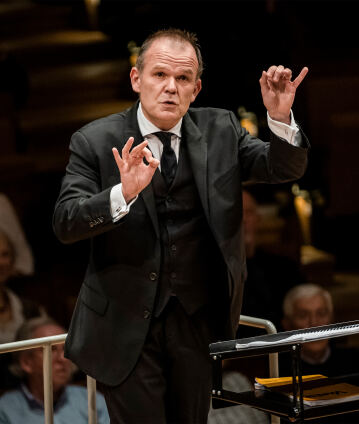“Late Night” concert with François-Xavier Roth

Most of Edgard Varèse’s works are witty miniatures. But at the time of their creation nearly a hundred years ago, they embodied a tangible revolution – with new forms of composition and a hitherto unknown fusion of sound and music. This is shown, for example, by the famous Ionization in which percussion, pianos and sirens create a mysterious nocturnal scene. In this Late Night concert, François-Xavier Roth presents original works by the French composer.
Sound visions in the late evening: “Imagine the projection of a geometrical figure on a plane with both figure and plane moving through space, each with its own arbitrary and varying speeds of translation and rotation.” Edgard Varèse was fascinated by a composed spatial movement of sounds – as he was by using different noise values that were achieved primarily by percussion instruments and went down in music history as “the liberation of sound”. All this is clearly evident in works such as Hyperprism, Intégrales and Ionisation.
Besides these works, at this Late Night members of the Berliner Philharmoniker and François-Xavier Roth will also dedicate themselves to Edgard Varèse’s Octandre, in which the composer, full of vitality, turned his back on the traditional string sound, which for him represented the 18th and 19th century, with four individual woodwind players, three brass players and a double bass. In Offrandes, on the other hand, the soprano voice is surrounded by orchestral atmospheres, with a palette of sounds ranging from the softest pianissimo to a sudden eruption.
21.5 is the density of platinum, and it gave Density 21.5 for flute its title: Varèse composed the work for the flutist Georges Barrère, who had requested a short solo with which he wanted to present his new platinum instrument in 1936 at a New York gala concert. Varèse reached the ultimate “liberation of sound” in his last works for electronics, including in his Poème électronique for electronic tape, which was heard by several million people during the 1958 Brussels World’s Fair in Le Corbusier’s Philips Pavilion.
© 2019 Berlin Phil Media GmbH
Related interviews
Category
Artists
Our recommendations
- “Late Night” concert with Simon Rattle
- A “Late Night” concert with French chamber music and Simon Rattle at the piano
- “Late Night” concert with Patricia Kopatchinskaja: “Nonsense in Residence”
- Schubert’s “Winterreise” with Christian Elsner and Simon Rattle
- Barbara Hannigan and Simon Rattle with “Façade” by William Walton
- “Late Night” concert with HK Gruber’s “Frankenstein!!”